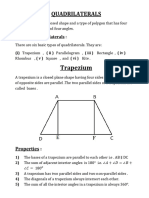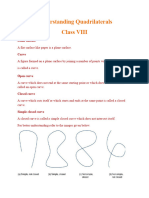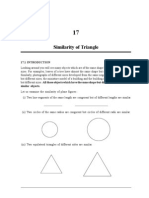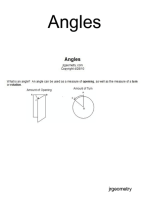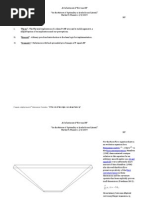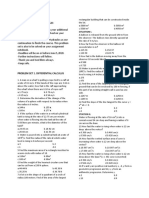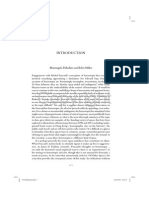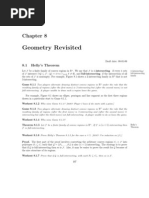Properties of Parallel Lines
Properties of Parallel Lines
Uploaded by
SupernaliaCopyright:
Available Formats
Properties of Parallel Lines
Properties of Parallel Lines
Uploaded by
SupernaliaOriginal Description:
Copyright
Available Formats
Share this document
Did you find this document useful?
Is this content inappropriate?
Copyright:
Available Formats
Properties of Parallel Lines
Properties of Parallel Lines
Uploaded by
SupernaliaCopyright:
Available Formats
The Mathematics 11 Competency Test
Properties of Parallel Lines
Two lines are said to be parallel if (i) they both lie in the same plane, and, (ii) they do not intersect (or cross each other) Since a line is considered to extend indefinitely in both directions, this definition really means that parallel lines never cross no matter how far you check in either direction. A transversal is a third line that crosses a pair of parallel lines on a slant, as shown in the illustration to the right. As the transversal crosses the two parallel lines, eight angles are formed, numbered 1 through 8 in the illustration. You can see that four of the angles are quite large, and four of them are quite small. A very important set of properties of these angles is that the angles which appear to be the same in the illustration really are exactly the same. Thus, 1 = 3 = 5 = 7 and 2 = 4 = 6 = 8 Also, pairs of adjacent angles always add up to 180o, as you can easily see from the figure. Thus 1 + 2 = 180o, 2 + 3 = 180o, 3 + 4 = 180o, 5 + 6 = 180o, etc. There is some terminology when talking about this situation: angles in the same relative position around the two intersection points are called corresponding angles. Thus 1 and 5 are corresponding angles, as are 4 and 8, 2 and 6, and also 3 and 7. Corresponding angles are equal. 3 and 5 are called alternate interior angles. 4 and 6 are also alternate interior angles. Alternate interior angles are equal. 2 and 8 are called alternate exterior angles. 1 and 7 are also alternate exterior angles. Alternate exterior angles are equal. These properties of parallel lines are important in understanding and exploiting the properties of similar triangles soon to be described in these notes. These properties also work both ways. For instance, all it takes to determine that two lines are parallel is to demonstrate that when a transversal is drawn across them, one of the pairs of corresponding angles formed is equal.
3 parallel lines 7 6 5 8 a transversal
2 1 4
David W. Sabo (2003)
Properties of Parallel Lines
Page 1 of 2
Example: Determine the values of angles A, B, C, and D, in the figure to the right. Assume that the horizontal lines are parallel. solution: Since angle B is the alternate interior partner of the given angle of 700, and alternate interior angles are equal, we have immediately that B = 700
A C B 700 D
Angle C and the given angle of 700 are corresponding angles, and corresponding angles are equal, so C = 700. Angles A and B are adjacent, so they must add up to 1800. Thus A + B = A + 700 = 1800 so A = 1800 700 = 1100
Similarly, angle D is adjacent to the given angle of 700, so the two must add up to 1800. That is D + 700 = 1800. so D = 1800 700 = 1100
Thus, our solution is: A = 1100, B = 700, C = 700 and D = 1100.
While were on the topic of lines and angles, just a reminder of one more simple, but very useful property. When two lines cross, as shown in the diagram to the right, they form four angles. 1 and 3 are said to be vertical angles (or sometimes vertically opposite angles, though the word opposite is a bit redundant) 2 and 4 also form vertical angles. As is fairly obvious from the diagram, vertical angles are equal. Thus 1 = 3 and 2 = 4
2 3
1 4
David W. Sabo (2003)
Properties of Parallel Lines
Page 2 of 2
You might also like
- G8 Term+3 AnglesDocument20 pagesG8 Term+3 AnglesRam AthreyapurapuNo ratings yet
- New Microsoft Power Point PresentationDocument5 pagesNew Microsoft Power Point PresentationNitun PanigrahyNo ratings yet
- Lines and Angles - Definitions & PropertiesDocument7 pagesLines and Angles - Definitions & PropertiesArijit DeyNo ratings yet
- Selfstudys Com File (3)Document7 pagesSelfstudys Com File (3)gourk525No ratings yet
- GeometryDocument15 pagesGeometryMajeanxNo ratings yet
- Math 9-Q3-Module-1Document11 pagesMath 9-Q3-Module-1Jeanette Agumbay AgunosNo ratings yet
- Yr12 Maths in Focus 2U HSCDocument412 pagesYr12 Maths in Focus 2U HSCRichard Yang93% (14)
- Math Assignment (Grade 7)Document11 pagesMath Assignment (Grade 7)Shabbir Ninja AttackNo ratings yet
- Line, Line Segment and Ray: Parallel Lines and A TransversalDocument5 pagesLine, Line Segment and Ray: Parallel Lines and A TransversalMidhun Bhuvanesh.B 7ANo ratings yet
- Class-Ix Chapter-6 Lines and Angles: It Is Denoted byDocument10 pagesClass-Ix Chapter-6 Lines and Angles: It Is Denoted byGuruSeeker11No ratings yet
- Ch-4 RD MathsDocument140 pagesCh-4 RD MathsThe VRAJ GAMESNo ratings yet
- Bank Job Math Lec 14Document23 pagesBank Job Math Lec 14MusaNo ratings yet
- Line 3Document12 pagesLine 3msalha2010No ratings yet
- Pairs of AnglesDocument4 pagesPairs of AnglesPRINTDESK by Dan100% (1)
- MIF Textbook HSC Maths 2 Units PDFDocument412 pagesMIF Textbook HSC Maths 2 Units PDFHIMMZERLAND100% (1)
- ch1 PDFDocument27 pagesch1 PDFerakiuydfoiawudNo ratings yet
- Lines and AnglesDocument10 pagesLines and AnglesNandhagopal MohanrajNo ratings yet
- INTRODUCTION GEOMETRY ch4Document24 pagesINTRODUCTION GEOMETRY ch4Jama abdi ibraahim100% (1)
- Mathematics (2 Unit) : Based On 1983 Syllabus, Written in 2004Document16 pagesMathematics (2 Unit) : Based On 1983 Syllabus, Written in 2004PaulNo ratings yet
- CH 6Document38 pagesCH 6api-297234970No ratings yet
- Section 8 - Geometry and TrigonometryDocument84 pagesSection 8 - Geometry and TrigonometryJerine GreeneNo ratings yet
- Parallel LinesDocument14 pagesParallel LinesMa. Francia100% (1)
- Quadrilateral 1Document23 pagesQuadrilateral 1Vamsi GuptaNo ratings yet
- Eometry Ensuration Rigonometry: Review TestDocument37 pagesEometry Ensuration Rigonometry: Review TestRaju RayhanNo ratings yet
- With Explanation Reviewer in Math 7Document108 pagesWith Explanation Reviewer in Math 7azores.preciousclaudtte.lNo ratings yet
- Geometry of Straight LinesDocument17 pagesGeometry of Straight LinesPaula FanaNo ratings yet
- Mathematics Grade 10 Weeks 1-5 - Term 3Document63 pagesMathematics Grade 10 Weeks 1-5 - Term 3Daniel Dowding100% (1)
- Transformations2Document7 pagesTransformations2MURALEE A/L VEERAMALAI MoeNo ratings yet
- Similarity of TrianglesDocument38 pagesSimilarity of TrianglesunikxocizmNo ratings yet
- 6th - Maths - Basic Geometrical IdeasDocument20 pages6th - Maths - Basic Geometrical Ideasvaibhav singhNo ratings yet
- Fundamental Properties For Writing A Two Column ProofDocument11 pagesFundamental Properties For Writing A Two Column Proofgv2rodrigo0803No ratings yet
- FINAL ELECTIVE MATHEMATICS 8 Module 2 4th QuarterDocument14 pagesFINAL ELECTIVE MATHEMATICS 8 Module 2 4th QuarterCharles Darryl ArciagaNo ratings yet
- Quadrilateral SDocument13 pagesQuadrilateral SBiplabNo ratings yet
- TexteDocument3 pagesTextemwambilaverdie829No ratings yet
- Lesson Plane and SolidDocument89 pagesLesson Plane and Solidedrian espedillonNo ratings yet
- Ch1 Geometry 2Document47 pagesCh1 Geometry 2trantuanan123No ratings yet
- Vertically Opposite Angles DefinitionDocument3 pagesVertically Opposite Angles Definitionapi-174391216No ratings yet
- Triangles: Class - Viii AryabhattaDocument46 pagesTriangles: Class - Viii Aryabhattarajesh duaNo ratings yet
- Chapter - 6: (Lines and Angles)Document7 pagesChapter - 6: (Lines and Angles)manish khichiNo ratings yet
- Notes On Euclidean GeometryDocument117 pagesNotes On Euclidean Geometrythabisojunior369No ratings yet
- Math 106Document38 pagesMath 106ShailendraPatelNo ratings yet
- Chapter 6 Lines and AnglesDocument9 pagesChapter 6 Lines and Anglessanjaykr4991No ratings yet
- Quadrilaterals: PolygonsDocument16 pagesQuadrilaterals: Polygonssanjay sharanNo ratings yet
- Notes Understanding QuadrilateralsDocument11 pagesNotes Understanding QuadrilateralsAbhishek SinghNo ratings yet
- Search 79,668 Tutors: Properties of ParallelogramsDocument18 pagesSearch 79,668 Tutors: Properties of Parallelogramsangelito peraNo ratings yet
- Eucledan GeometryDocument39 pagesEucledan GeometryUrsula VersterNo ratings yet
- Mathematics Similar Triangles 8 EngDocument35 pagesMathematics Similar Triangles 8 Engsbk4756No ratings yet
- Consolidation (3) - 76-113Document38 pagesConsolidation (3) - 76-113khanatipchokoonkitNo ratings yet
- Other Types of Quadrilaterals: Rectangles, Rhombi, Squares Trapezoids, KitesDocument17 pagesOther Types of Quadrilaterals: Rectangles, Rhombi, Squares Trapezoids, KitesHazel Clemente CarreonNo ratings yet
- Revalidated MATH GR8 QTR4-MODULE-3 32-PagesDocument32 pagesRevalidated MATH GR8 QTR4-MODULE-3 32-PagesHUMSS-F8TornoLorin AgathaNo ratings yet
- Chapter 10. Lines and AnglesDocument29 pagesChapter 10. Lines and Angleshoneygarg1986100% (1)
- Math Class NotesDocument18 pagesMath Class NotesthemantisspamNo ratings yet
- 1ESO U7 DossierDocument13 pages1ESO U7 DossierNatalia Martínez CabezaNo ratings yet
- Chapter 6Document39 pagesChapter 6dallaramNo ratings yet
- Geometric Designs: Basic ConceptsDocument22 pagesGeometric Designs: Basic ConceptsRye FelimonNo ratings yet
- MAT 146 Guided NotesDocument135 pagesMAT 146 Guided Notescrystalavalos12No ratings yet
- Similarity of Triangle 95Document21 pagesSimilarity of Triangle 95naveenrai_dce100% (1)
- Mathematical Analysis 1: theory and solved exercisesFrom EverandMathematical Analysis 1: theory and solved exercisesRating: 5 out of 5 stars5/5 (1)
- Hyperbolic Functions: with Configuration Theorems and Equivalent and Equidecomposable FiguresFrom EverandHyperbolic Functions: with Configuration Theorems and Equivalent and Equidecomposable FiguresNo ratings yet
- A Solution To P Equals NPDocument4 pagesA Solution To P Equals NPm.mm@vzw.blackberry.netNo ratings yet
- Position Lines and PositionDocument14 pagesPosition Lines and PositionVibhav Kumar100% (1)
- Psychology of Space The Psycho-Spatial ADocument20 pagesPsychology of Space The Psycho-Spatial AAreeba HasanNo ratings yet
- Final Requirement On Ce 523: Situation IDocument4 pagesFinal Requirement On Ce 523: Situation ICzindy MoradosNo ratings yet
- Phys 101 - 2023-2024 - FallDocument1 pagePhys 101 - 2023-2024 - FallEylülNo ratings yet
- Aspects of Modernism Maison Dom-Ino and The Self Referential Sign - Peter EisenmannDocument14 pagesAspects of Modernism Maison Dom-Ino and The Self Referential Sign - Peter EisenmanntzlkiqnvjlawjmxuxrNo ratings yet
- Curves and Singularities Bruce GiblinDocument40 pagesCurves and Singularities Bruce Giblinjennie aranzalezNo ratings yet
- Maths Module 3B Solutions PDFDocument41 pagesMaths Module 3B Solutions PDFShashankAnilNo ratings yet
- TrigonometryDocument181 pagesTrigonometrymark4102No ratings yet
- Multiple Choice Questions in Engineering Mathematics by Perfecto B. Padilla JRDocument101 pagesMultiple Choice Questions in Engineering Mathematics by Perfecto B. Padilla JRJeric Ponteras100% (2)
- Introduction To The Globalization of SpaceDocument12 pagesIntroduction To The Globalization of SpacePickering and ChattoNo ratings yet
- Circular Motion (29-04-2021)Document3 pagesCircular Motion (29-04-2021)Maroofa BhatNo ratings yet
- Tangents and NormalsDocument15 pagesTangents and Normalstapas yogiNo ratings yet
- Pysics 1Document17 pagesPysics 1s_murugan02No ratings yet
- Tensor Voting: Theory and Applications: Gérard Medioni Chi-Keung Tang Mi-Suen LeeDocument10 pagesTensor Voting: Theory and Applications: Gérard Medioni Chi-Keung Tang Mi-Suen LeeM Rameez Ur RehmanNo ratings yet
- 4.1 - 4.3 Quiz (2016)Document12 pages4.1 - 4.3 Quiz (2016)inizimijNo ratings yet
- Herstein: Topics in Algebra - Homomorphisms: by Bret Sherfinski June 21, 2015Document2 pagesHerstein: Topics in Algebra - Homomorphisms: by Bret Sherfinski June 21, 2015Lakshmi NarayanNo ratings yet
- 1.5 The Vibrating String: T U X UDocument7 pages1.5 The Vibrating String: T U X USyed Beeban BashaNo ratings yet
- BCO GRADE 9 MATHEMATICS Q3 Calendar Type 2020Document2 pagesBCO GRADE 9 MATHEMATICS Q3 Calendar Type 2020Din Flores MacawiliNo ratings yet
- Kinematics PDFDocument7 pagesKinematics PDFBetseha MerawiNo ratings yet
- Sudoku, Gerechte Designs, Resolutions, Affine Space, Spreads, Reguli, and Hamming CodesDocument31 pagesSudoku, Gerechte Designs, Resolutions, Affine Space, Spreads, Reguli, and Hamming CodesMahmoud NaguibNo ratings yet
- Chapter 10 - CirclesDocument20 pagesChapter 10 - CirclesshaunakaleleNo ratings yet
- Usamo 2000: Day 1 - 02 May 2000Document2 pagesUsamo 2000: Day 1 - 02 May 2000SeanGeeNo ratings yet
- Geometry Revisited: 8.1 Helly's TheoremDocument4 pagesGeometry Revisited: 8.1 Helly's TheoremtarcisinhoferreiraNo ratings yet
- Math 4a Chapter 10 Powerpoint PresentationDocument23 pagesMath 4a Chapter 10 Powerpoint PresentationAtul DhimanNo ratings yet
- Chapter 1 - Orthographic ProjectionDocument135 pagesChapter 1 - Orthographic ProjectionayobamiNo ratings yet
- Stereoisomerism - Mind Maps - (JEE Ultimate CC 2.0 2023)Document1 pageStereoisomerism - Mind Maps - (JEE Ultimate CC 2.0 2023)ShahzadNo ratings yet
- Circular Measure (Exercise)Document5 pagesCircular Measure (Exercise)Zaweyah SulaimanNo ratings yet
- Fractional Calculus and The Future of ScienceDocument314 pagesFractional Calculus and The Future of Scienceantoni202201No ratings yet
































